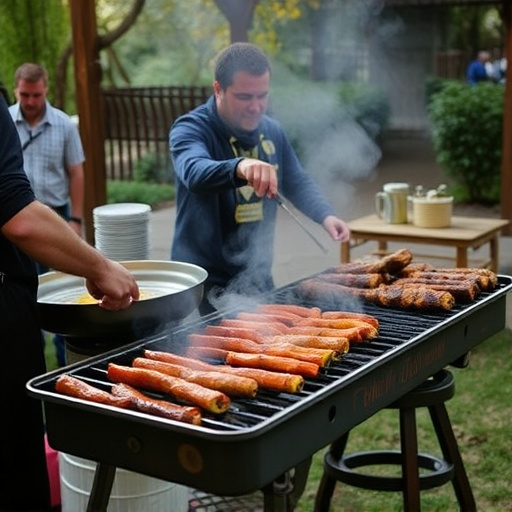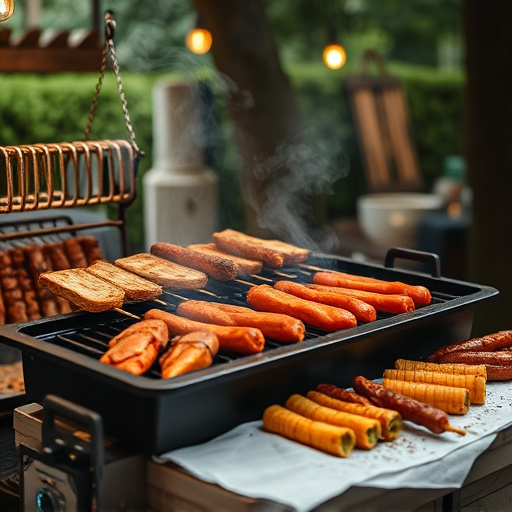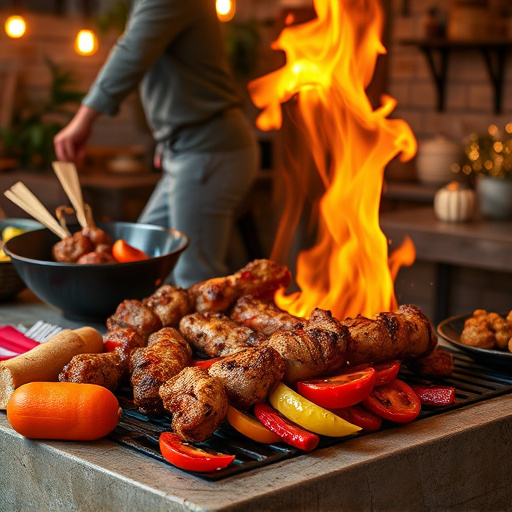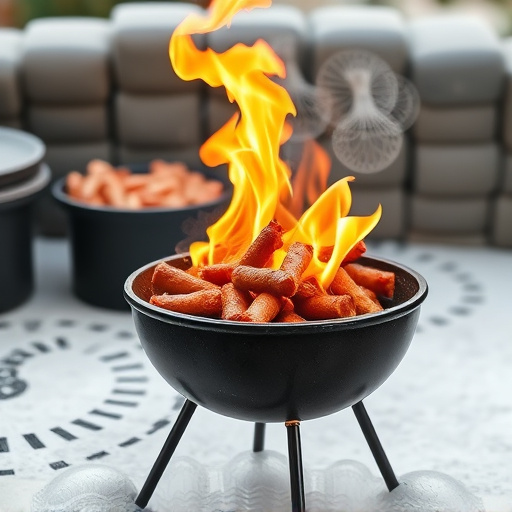Selecting the point cut of beef brisket ensures melt-in-your-mouth tenderness for smoked BBQ brisket recipes due to its abundant marbling. A dry rub blend of salt, pepper, garlic, onion powder, smoked paprika, cayenne, and chili powder enhances flavor and prevents toughness. Smoking at 225°F to 250°F for approximately 1 hour per pound breaks down collagen, with regular wood additions infusing flavors. Wrap brisket in butcher paper once internal temp reaches 165°F to retain moisture. Pair with sides like potato wedges, coleslaw, cornbread, and sauces for a complete smoked BBQ brisket experience.
Indulge in the ultimate comfort food: melt-in-your-mouth smoked beef brisket, a masterpiece that transforms simple meat into a flavorful sensation. This guide unveils the secrets to achieving tender, juicy results. From selecting the ideal cut to mastering dry rubs and smoking techniques, we’ll walk you through every step. Learn how to time your cooking perfectly and discover mouthwatering serving suggestions, including delectable accompaniments and sauces. Uncover the art of crafting a perfect Smoked BBQ Brisket Recipe that’s sure to impress.
- Choosing the Perfect Cut for Smoked Brisket
- Dry Rub: The Secret to Flavor Infusion
- Smoking Techniques and Timings for Tender Results
- Serving Suggestions: Accompaniments and Sauces
Choosing the Perfect Cut for Smoked Brisket

When it comes to smoked brisket, selecting the right cut is half the battle won. For a melt-in-your-mouth texture, look no further than the beef brisket’s point cut. This section, located at the front of the brisket, boasts abundant marbling and well-distributed fat, which renders it incredibly tender during the slow-smoking process. Its rich flavor profile, a blend of deep beefy notes with hints of fat, makes it ideal for that coveted smoky, juicy BBQ brisket recipe you’ve been craving.
Unlike the flat cut, known for its leanness, the point cut’s generous marbling ensures it stays moist and flavorful throughout the smoking process. This is particularly important as the low and slow cooking technique used in smoked BBQ brisket recipes can otherwise lead to a tough texture. So, if you’re aiming for that signature mouthfeel and taste of a perfect smoked brisket, choose the point cut for an unforgettable culinary experience.
Dry Rub: The Secret to Flavor Infusion

The dry rub is a crucial element in achieving that mouthwatering, smoky flavor in your brisket. This blend of spices acts as the first line of defense against the harsh effects of smoking, infusing the meat with deep, savory notes throughout the slow-cooking process. A well-balanced dry rub typically includes a mix of salt, pepper, garlic powder, and onion powder, along with more robust flavors like smoked paprika, cayenne, or chili powder—all carefully measured to create a symphony of taste that complements the beef brisket’s natural juices.
When applied correctly, the dry rub not only enhances the brisket’s flavor but also helps to dry out the meat slightly, which is essential for achieving that perfect texture. As the brisket smokes, the spices adhere to its surface, slowly releasing their aromas and flavors into the meat, resulting in a tender, succulent end product that literally melts in your mouth. For optimal results in your smoked BBQ brisket recipe, make sure to rub the spice mix generously onto all sides of the meat before sealing it for smoking.
Smoking Techniques and Timings for Tender Results

Achieving melt-in-your-mouth smoked beef brisket starts with understanding the art of smoking techniques and timing. The classic method involves using a smoker at a consistent temperature range between 225°F to 250°F (107°C to 121°C). This low and slow approach allows the collagen in the brisket to break down gradually, resulting in tender, juicy meat. Smoking times can vary greatly depending on the size of the brisket and your smoker’s efficiency, but a good rule of thumb is to plan for approximately 1 hour per pound at these temperatures.
For optimal results, maintain the smoker’s temperature with regular wood chunks or pellets added as needed. The aroma of hickory, mesquite, or oak smoke infuses the brisket with flavor during the process. Once the internal temperature reaches around 165°F (74°C), wrap the brisket in butcher paper to retain moisture and speed up the rendering process. This step, known as “resting,” allows the juices to redistribute, ensuring a tender, succulent final product when you slice into your smoked BBQ brisket recipe.
Serving Suggestions: Accompaniments and Sauces

For a truly immersive smoked BBQ brisket experience, pair your perfectly cooked meat with complementary sides and sauces. Consider crispy, homemade potato wedges or coleslaw for a classic combination that cuts through the richness of the brisket. Cornbread, either as a side or crumbled on top, adds a delightful crunch and depth of flavor. Sauces are an essential element in enhancing the BBQ brisket recipe; opt for a traditional tomato-based sauce or venture into apple cider vinegar and brown sugar glazes for a sweeter twist. Barbecue sauces with smoky notes will elevate the overall taste profile, while pickled vegetables offer a refreshing contrast to the rich meat.
